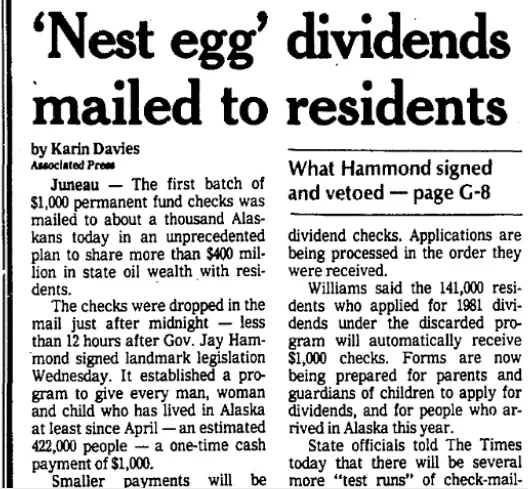Dunleavy history lesson goes wrong on 'Dividend Appreciation Day'
On June 14, Gov. Mike Dunleavy gave a pop quiz to reporters: “As an old history teacher does anyone remember what happened 37 years ago? Come on.”
No one had the answer, so the old history teacher schooled the assembled scribes and broadcasters: “This is the day the first PFD check was issued in the state of Alaska, 37 years ago today.”
Dunleavy, who moved to Alaska 36 years ago, wanted to make sure Alaskans appreciated what someone had told him was the PFD anniversary, so he issued an official proclamation declaring June 14 as “Permanent Fund Dividend Appreciation Day.”
It’s the wrong day. In the interest of history, the old history teacher should correct the record and appreciate the right day, which was not June 14, but June 16, 1982 or June 17.
One of the “whereas” clauses of the official June 14 proclamation said that “on this day, 37 years ago, the first dividend checks of $1,000 were distributed to Alaskan residents…”
An important event did take place on June 14, 1982 regarding the Permanent Fund Dividend. That was the day on which the U.S. Supreme Court declared the Permanent Fund Dividend unconstitutional.
This left Gov. Jay Hammond so discouraged he almost didn’t sign the replacement plan approved that month by the Legislature. In the end, he signed Senate Bill 842 on June 16, 1982, with an effective date of June 17, 1982. With that action, the dividend checks began.
Hammond’s original plan, approved by the Legislature in 1980, rewarded long-term residents with much bigger dividends than newcomers. Alaskans who had lived in the state since 1959 would have gotten $1,050, while a one-year resident would have gotten $50.
In the hearing before the Supreme Court in 1981, Attorney General Avrum Gross delivered a string of convoluted and contradictory arguments that didn’t go over well.
Here is the audio of the Supreme Court arguments in which Gross also said that paying larger dividends to long-term residents would give them an incentive to support policies that would keep dividends larger and lead to greater contributions to the Permanent Fund.
Paying the same amount to everyone regardless of years of residency would defeat the purpose of the fund, he argued.
“Now, if you take the dividends and you distribute them on a per capita basis each year, having nothing to do with the length of residency in the state, each person, what you have is a situation where people's psychology, the very incentive that you're using here, personal desire to get the money, isn't going to take long that the more people that come, the less they're going to get,” Gross said during the hearing on Oct. 7, 1981.
“Now, they can't stop people from coming, nor is there any desire to stop people from coming,” he said. “But when you do that, it's going to create some other pressures.”
“It's going to create, for instance, pressures on the Legislature to get the maximum money not only in the Permanent Fund but out of the Permanent Fund as quickly as possible; because if they get it now, they don't have to worry about sharing it with five million people who will come to Alaska in ten years or twenty years.”
“Now, if you're saying that, you know, people shouldn't think this way, you may have a point; but I think individuals do think this way when they're looking at money that they're going to receive,” he said.
There was an extended exchange between Gross and Justice Thurgood Marshall about equal treatment. “Does everybody get the same?” Marshall asked.
“Everybody gets the same over the same period of residency,” Gross replied.
Marshall kept asking about cash. “That’s what this case is about, cash,” Marshall said. “You started off by saying you were loaded with cash.”
“I think this case, Justice Marshall, is about the participation in a plan where everyone has equal rights to receive the same amount of cash over the same period of residency for certain valid public purposes. That's what the case is about.”
“If you want to look at it on a one year basis, yes, people get different amounts of cash, just as under welfare systems people get different amounts of welfare depending upon how they meet the criteria.”
Hammond claimed later that the judges “never let Av present our basic arguments” and that the 8-1 vote striking down the law was the greatest disappointment in his political life. He told some of his aides that he planned to veto the 1982 bill, but changed his mind.
He signed the bill on June 16 and less than 12 hours later, shortly after midnight, about 1,000 checks were ready for the mail. The first distribution was $1,000 to those who would have at least six months residency by October 1982..
The Anchorage Times published this AP account of the first dividend checks on June 17, 1982.

